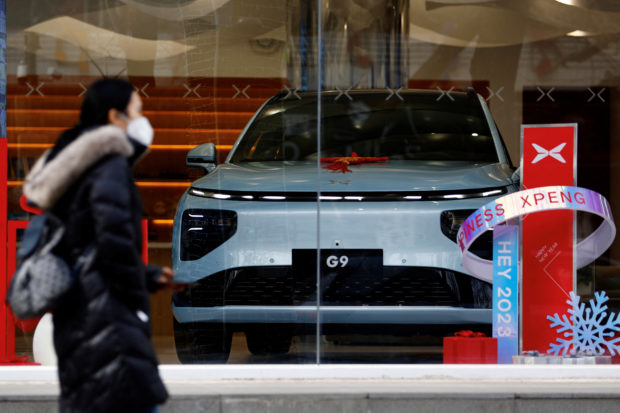In China, Tesla could win electric vehicle price battle – but lose the war

A person walks past an XPeng G9 electric vehicle (EV) at its flagship store in Beijing, China Feb 2, 2023. REUTERS/Tingshu Wang
SHANGHAI – Slashed prices have given Tesla’s China sales a pop, but analysts – and even fans – warn the U.S. automaker needs to up its long-term game to avoid choking on the dust of fast-moving rivals in the world’s biggest electric vehicle market.
Most immediately, Tesla’s January price cuts drove deliveries of its China-made vehicles up 18 percent from December. Tesla’s thick profit margins have put it in a position to take a price war to competitors in China and beyond, analysts say.
But they say Tesla has lagged competitors in China in introducing new models, improving navigation systems and adding luxe interior touches or white-glove customer service to serve the developing range of consumer preferences for EVs.
“Tesla’s facing a serious problem of a very limited product mix,” said Cui Dongshu, secretary general of China Passenger Car Association (CPCA). “Its slowness to respond to Chinese consumers’ preferences has led to a very passive positioning for Tesla to rely on few means such as price cuts to stay competitive.”
Even Tesla chief executive Elon Musk himself has conceded that China is where his firm could face its toughest competition.
Tesla did not respond to Reuters’ request for comment on its China business. Grace Tao, Tesla’s vice president in charge of external communications in China, said previously the price cuts in China reflected engineering innovation and answered Beijing’s call to encourage economic development and consumption.
China’s Association of Automobile Manufacturers expects sales of EVs and plug-in hybrids to surge by 35 percent in 2023 to 9 million vehicles – nearly a third of China’s total new vehicle sales.
While Tesla has increased sales in China, its second-largest market, it has also lost share. From 15 percent in 2020, its share of the China EV market fell by a third to just 10 percent in 2022, according to data from the CPCA.
Tesla offers two models in China, the Model 3 sedan and the Model Y crossover. That keep-it-simple approach has driven scale and driven down costs.
After the latest price cuts, the Model 3 starts at about $34,000 and the Model Y at $38,000. But Chinese car shoppers, back out in showrooms this year after the end of China’s tough COVID-19 curbs, are being courted by competitors offering a broad range of alternatives.
BYD, which overtook Tesla by global sales volume last year and has a market value well over $100 billion, offers more than 60 different versions of EV and plug-in hybrid cars. Much smaller but ambitious peer Nio has gone from two models to six over the same period and plans to launch five more this year.
“The aging product line is a real problem for Tesla,” said Yale Zhang, managing director at Shanghai-based consultancy Automotive Foresight. “Once BYD and other EV startups follow to lower prices, the effect of Tesla’s price cuts could vanish in the blink of an eye.”
No U-turn at Tiananmen
Tesla’s self-driving software and navigation systems, touted by CEO Musk as competitive strengths, have also come under criticism from customers about slow updates and errors on Chinese roads. Luxury EV buyers who employ drivers are less interested in paying more for the software.
Chang Yan, a 34-year-old Chinese auto blogger, who was among Model 3 buyers in China in 2018, said his car still asks him to make U-turns on strictly guarded Chang’an Avenue near Tiananmen Square, where such moves are banned.
“This is a sharp contrast with Nio, (EV brands) Xpeng and Li Auto, whose navigation aids have been working almost perfectly,” said Chang, who also drives a Nio sedan.
Tesla has been considering a shift in its marketing in China, focusing more on energy efficiency, practical features and less on cutting-edge functionality, a person with knowledge of the matter said.
It has also been studying how its Chinese rivals, led by BYD, win over customers in showrooms, especially in smaller cities, the person said, declining to be identified citing lack of authorization to speak to media.
One takeaway: BYD ensures that bottles of drinking water offered to showroom visitors are warm in winter in a nod to local preferences.
Tesla, which early this year promoted its China Chief Tom Zhu to head global sales and production, is also giving its China sales team a more direct line to product development engineers to provide local feedback, the person with knowledge of the matter said.
Less is more?
To be sure, the Tesla design aesthetic, with sparse interiors and synthetic leather, still appeals to many.
Cui Yang, a 31-year-old doctor shopping for a Tesla in Beijing after the recent price cut, said he was won over by “the minimalist interior style and tech feeling”.
On the flipside, Chinese brands like Nio and Zeekr tout their butter-smooth Napa leather and traditional luxury features like seats with massage functions aimed as much at the passenger experience as the driver’s.
Some EV makers see that premium segment of the market growing fast in coming years.
Li Auto is targeting EV buyers looking for cars that can transport families, who expect to pay above Tesla’s current pricing, starting at about $44,000, a sales category it expects will represent 10 million vehicles in market-wide sales by 2025.
Then there is a ‘buy local’ challenge for Tesla.
Chinese consumers like 50-year-old Lin Wenwei, who want to support a Chinese brand – even though Tesla makes the EVs it sells in China.
“I have always been more inclined to buy a domestic EV brand for the national industry,” said Lin while he was trying out a Seal sedan for his son in a BYD dealership store in suburban Shanghai – after getting a BYD Dolphin hatchback for himself.
($1 = 6.7973 Chinese yuan renminbi)